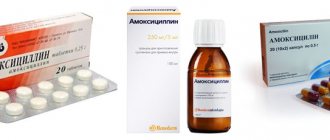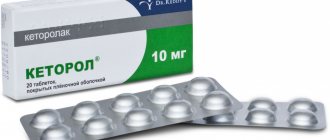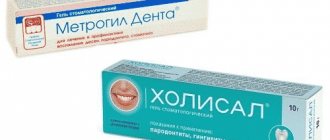Pain management is the most common process in all of medicine. There are many ways to relieve pain of all kinds (from using any cold object to surgical methods), but one of the simplest, most common and effective is medication, namely by taking pills.
Today, drugs such as Ketorol and Ketonal are extremely popular. These drugs can be used both in tablet form and in injection form, however, tablets, due to their ease of use, high availability and equally high effectiveness, are replacing the injection forms of these drugs in terms of prevalence.
Every person should clearly know that despite their names being very similar to each other and the general class of medications, Ketonal and Ketorol are different drugs. This difference needs to be understood in detail.
Characteristics of Ketonal
This is a non-narcotic, non-hormonal drug, characterized by antipyretic, anti-inflammatory and analgesic properties. It helps relieve moderate and severe pain of various origins, for example, with colic, neuralgia, myalgia, radiculitis, osteoarthritis, spondylitis, arthritis, etc.
Dosage forms of Ketonal:
- pills;
- gel;
- cream;
- rectal suppositories;
- solution in ampoules for intravenous or intramuscular administration;
- capsules.
The main active component of the drug is ketoprofen. This substance belongs to the group of nonsteroidal anti-inflammatory drugs (NSAIDs). A distinctive feature of the drug is the provision of a wide range of analgesic effects, distributed to the peripheral and central nerve fibers that are responsible for the perception of pain impulses. Therefore, Ketonal is often used for pain in joints, muscles, and ligaments. The drug reduces inflammatory reactions, which helps relieve pain in joint diseases and relieves morning stiffness.
Tablets, injections, suppositories and capsules are prescribed for the treatment of degenerative or inflammatory diseases of cartilage, ligaments, muscles, joints and bones:
- rheumatoid arthritis;
- glenohumeral syndrome;
- rheumatism;
- gout and pseudogout;
- osteochondrosis;
- osteoarthritis;
- arthrosynovitis;
- periarthritis;
- polyarthritis;
- reactive arthritis;
- ankylosing spondylitis;
- psoriatic arthritis.
To relieve pain, doctors often prescribe drugs such as Ketonal or Ketorol.
In addition, these dosage forms are prescribed to relieve severe or moderate pain in the following diseases and conditions:
- phlebitis;
- lumbago;
- lumbodynia;
- sciatica;
- radiculitis;
- neuralgia;
- myalgia;
- headache;
- bursitis;
- tendinitis;
- lymphadenitis and lymphangitis;
- pain after operations, injuries, during menstruation and malignant tumors.
Gel and ointment are indicated in the following cases:
- periarthritis and rheumatoid arthritis;
- neuralgia;
- myalgia;
- bursitis, tendinitis;
- osteoarthritis;
- reactive arthritis;
- psoriatic arthritis;
- ankylosing spondylitis;
- ruptures of tendons and muscle ligaments, sprains, bruises of ligaments and muscles, injuries to the musculoskeletal system;
- radiculitis.
Contraindications for Ketonal include:
- intolerance to drugs of the NSAID group;
- bleeding disorders;
- exacerbation of inflammatory bowel diseases (enteritis, Crohn's disease, etc.);
- exacerbation of a stomach or duodenal ulcer;
- chronic digestive disorders (constipation, diarrhea, flatulence, etc.);
- bleeding of any location (uterine, gastrointestinal, etc.);
- coronary artery bypass grafting performed less than 2 months ago;
- heart failure;
- progressive kidney disease;
- severe liver or kidney failure;
- third trimester of pregnancy;
- breastfeeding;
- children under 15 years of age.
We recommend reading: What is the difference between Dona and Teraflex?
Contraindications for Ketonal include: intolerance to NSAIDs, blood clotting disorders.
Cream and gel should not be applied to wounds on the skin (wetting dermatitis, eczema, open wound, etc.).
TREATMENT AND PREVENTION OF OSTEOARTHROSIS: DRUGS OF CHOICE (Part 1)
Preferanskaya Nina Germanovna
Associate Professor, Department of Pharmacology, Faculty of Pharmacy, First Moscow State Medical University named after. THEM. Sechenova, Ph.D.
Osteoarthritis or deforming arthrosis affects approximately 20% of the world's population over the age of 40 years. In Russia, this disease is observed in 10–12% of the population. Osteoarthrosis of the knee joint (gonarthrosis) develops more often in women, and of the hip joint (coxarthrosis) - in men.
The pathogenesis is based on a disruption of the normal metabolism of cartilage tissue in the direction of the predominance of catabolic processes over anabolic ones. It manifests itself as severe pain in the area of the affected joint or joints, deformation of the supporting joints (hip, knee), interphalangeal joints of the hands, and damage to the joints of the spine. With arthrosis (as opposed to arthritis), the inflammatory process is usually observed in the later stages of the disease. When cartilage is destroyed, synovitis can occur - inflammation of the inner layer of the joint capsule. Most often, osteoarthritis is the main cause of disability, second only to coronary heart disease.
Osteoarthritis cannot be completely cured; unfortunately, it inevitably progresses. For mild to moderate damage to the articular cartilage, good results are achieved with the help of complex conservative therapy, the essence of which is to reduce inflammation, swelling, relieve excess muscle tension, improve microcirculation and tissue oxygenation. The correct selection of medications becomes effective, safe, prevents disability, which significantly improves the quality of life of such patients.
Anti-arthrosis drugs include 7 main groups:
- Analgesics (painkillers with rapid symptomatic action)
- Non-steroidal anti-inflammatory drugs - NSAIDs (selective and non-selective), which have a powerful anti-inflammatory and analgesic effect
- Chondroprotectors of delayed action, modifying the structure of cartilage
- Synovial Fluid Protectors
- Local glucocorticosteroids (GCS)
- Homeopathic remedies with anti-inflammatory effects
- Biologically active food supplements (dietary supplements) recommended for osteoarthritis.
ANALGESICS (PAINKILLERS)
Analgesics selectively eliminate and reduce the feeling of pain without turning off consciousness or affecting other types of sensitivity. Analgesics used for osteoarthritis are divided into central and peripheral agents.
Tramadol
(Tradol, Tramal)
is a synthetic analgesic with central action that does not cause drug dependence. Tramadol - complementarily binds to m-receptors as an agonist. The analgesic effect is further mediated through effects on adrenergic and serotonergic transmission. The drug disrupts the neuronal uptake of norepinephrine and serotonin in descending antinociceptive pathways, resulting in increased descending inhibitory effects on the conduction of pain impulses at the level of the spinal cord. Compared to morphine, drugs have little drug-induced potential, cause less risk of drug addiction and are not included in the list of drugs. Use as directed by your doctor.
Important!
Side effects: possible occurrence of abdominal pain, dyspeptic disorders, allergic reactions, dizziness, dry mouth, convulsive reactions.
NON-NARCOTIC ANALGESICS
The analgesic effect of non-narcotic analgesics is associated with an inhibitory effect on the synthesis of prostaglandins (PG) in the central nervous system. The drugs inhibit the enzyme cyclooxygenase and reduce the formation of PGs involved in the development of the pain reaction. Reducing the synthesis of prostaglandins from arachidonic acid and inhibiting the release of biologically active substances (bradykinin, histamine) disrupts the conduction of painful extra- and proprioceptive impulses, reduces the sensitivity of nociceptive receptors to mechanical and chemical stimuli and increases the threshold of excitability of the thalamic centers of pain sensitivity.
Acetaminophen
(Paracetamol, Panadol, Efferalgan)
is a non-narcotic analgesic (analgesic-antipyretic), a derivative of paraaminophenol, an active metabolite of phenacetin, and has an analgesic and antipyretic effect. The analgesic effect is especially pronounced during inflammation. The effect on inflammation is due to the participation of the peripheral nervous system. Duration of action is 3–4 hours. Reduces pain of various origins and localization, but does not affect pain caused by spasms of smooth muscle organs. There is no anti-inflammatory activity, the drug does not have an antirheumatic effect. The analgesic effect is associated with inhibition of cyclooxygenase synthesis in the central nervous system. In therapeutic doses it rarely causes side effects.
Important!
Overdose is possible with long-term use and can lead to serious damage to the liver and kidneys, as well as allergic reactions (skin rash, itching).
Acetaminophen is self-prescribed for myalgia, arthralgia, and joint pain. The drug is available in tablets and capsules of 0.5 g, in the form of a suspension (10%) for oral administration and a solution (15%) for injection in ampoules. Combination drugs containing paracetamol are: Solpadeine, Pentalgin Plus, Pentaflucin, Citropar
and etc.
NSAIDs
Ketorolac (Ketalgin, Ketanov, Ketorol)
- a derivative of acetic acid, has pronounced analgesic activity, but has less anti-inflammatory effect compared to other NSAIDs. Ketorolac is well absorbed from the gastrointestinal tract; when administered orally, the bioavailability is 80–100%. Ketorolac is used orally and parenterally to relieve severe and moderate pain. The duration of use should not exceed 5 days. With long-term use of the drug, side effects occur that are characteristic of other NSAIDs (see instructions). Available in the form of tablets p/o 10 mg, solution for IM and IV administration 30 mg/ml/1 ml.
Ketoprofen (Artrosilene, Bystrumcaps, Ketonal, Fastum, Flamax)
- a derivative of phenylpropionic acid - has a pronounced analgesic effect, after 15 minutes. after administration, it penetrates into the central nervous system, reduces the synthesis of PG in the central nervous system, affects the thalamic centers of pain sensitivity, and suppresses the expression of COX-2 in the central nervous system. The analgesic effect occurs within 30 minutes. when administered orally, after 20 minutes. - with intramuscular administration and after 10–15 minutes. - with intravenous administration. Available in tablets and capsules 0.05 g, in the form of a spray (5%) for external use, bottles with a 50 ml sprayer, 5% solution for injection, ampoules. 2 ml, 2.5% gel and 5% cream tube 30 g.
Non-selective NSAIDs
are inhibitors of COX-1 and COX-2. This is a large group of drugs that have anti-inflammatory, analgesic and antipyretic properties (see MA No. 2/15, p. 16).
Diclofenac sodium (Voltaren, Dicloran SR, Ortofen, Ortoflex) has a strong analgesic and anti-inflammatory effect
derivative of phenylacetic acid.
Effective for rheumatoid diseases, well tolerated by patients. The anti-inflammatory effect develops after a few days, the onset of the analgesic effect after 30 minutes, duration 8 hours. The half-life of the drug is quite short (T½ = 1.5–2 hours), so prolonged forms were created: Revodina retard, Flameril retard, Diclofenac retard, Diclonate P retard 100
.
After taking the prolonged form, the concentration of the drug remains high for a long time and depends on the size of the administered dose. In terms of anti-inflammatory activity, Diclofenac sodium is significantly superior to Acetylsalicylic acid, Phenylbutazone and Ibuprofen. Available in the form of IM solution, tablets, enteric-soluble po tablets, prolonged po tablets, rectal suppositories, ointment, cream, gel. Diclofenac is available in combination under the TN " Dicloran Plus"
, as well as in the form of gel and tablets p/o "
Panoxen"
.
Important!
With long-term use of drugs with diclofenac, side effects characteristic of NSAIDs are observed.
A new generation of NSAIDs - a derivative of phenylpropionic acid - Dexketoprofen tromethanol (Dexalgin, Dexalgin 25)
, exhibits anti-inflammatory properties and a highly pronounced analgesic effect. It has a dual unique mechanism of action (central and peripheral): due to inhibition of the COX enzyme and inhibition of prostaglandin synthesis in the central nervous system, it inhibits the conduction of pain impulses and also suppresses irritation of pain receptors. It is the active dextrorotatory isomer of ketoprofen (99.9%). The drug has a rapid effect, the maximum concentration is observed after 30 minutes. Long-term treatment with the drug is not intended; administration is designed for 3–5 days. The main indications for use are pain of mild to moderate intensity and chronic inflammatory diseases of the musculoskeletal system.
Important!
The use of
Indomethacin
and
Piroxicam
is not recommended, because the drugs cause severe side effects, contribute to the progression of cartilage degeneration and interact poorly with antihypertensive and diuretic drugs.
Selective NSAIDs
, COX-2 inhibitors, have a pronounced anti-inflammatory, analgesic and antipyretic effect. The main mechanism of their action is the selective inhibition of the enzyme cyclooxygenase-2 (COX-2) and suppression of the synthesis of prostaglandins involved in inflammation, cell proliferation and destruction. Prostaglandins and related biologically active compounds (eicosanoids) are formed in almost all tissues and organs and have a strong effect on many physiological functions of the body. These compounds are mediators of inflammation, affect the hemodynamics of the kidneys, water-salt and fat metabolism, create conditions to prevent bleeding in the area of damage, stimulate the movement of leukocytes into the area of inflammation and phagocytosis of foreign compounds, etc. About drugs that selectively block COX-2 and affecting mainly the inflammatory process, was written in MA No. 2/15 as used in the treatment of gout. Their scope of application also includes the treatment of osteoarthritis.
Characteristics of Ketorol
This is a powerful analgesic with a fairly weak antipyretic and anti-inflammatory effect. It is most often prescribed to relieve moderate to severe pain, especially associated with injuries. The drug helps if the back hurts or a person suffers from migraines, neuralgia, radiculitis. Dosage forms: tablets, gel, solution for intravenous and intramuscular administration. The main component is ketorolac.
The mechanism of action of the drug is based on its ability to block the work of cyclooxygenase, a special enzyme that converts arachidonic acid into prostaglandins. These are substances that provoke the development of pain, inflammation and an increase in body temperature. Ketorol thins the blood well, so it is prescribed with caution to people suffering from diseases associated with bleeding (stomach ulcers, hemophilia, etc.).
Indications for use of the drug:
- injuries (synovitis, tendonitis, bursitis, ligament damage, soft tissue inflammation, bruises, etc.);
- radiculitis;
- neuralgia;
- pain in joints and muscles;
- osteoarthritis;
- pain syndrome after injury.
The analgesic effect of the drug is aimed at relieving pain, but does not eliminate its cause and does not cure the underlying disease. An overdose of the gel is impossible, but if it accidentally gets into the stomach, for example, when licked from hands, lips, etc., then you need to induce vomiting and take some kind of sorbent (activated carbon, Enterosgel, Polysorb).
Overdose with injection solution and tablets is possible. It manifests itself as symptoms of poisoning: nausea, vomiting, abdominal pain. In addition, other undesirable effects of the body may be observed:
- from the gastrointestinal tract: pancreatitis, enlarged liver, hepatitis, jaundice, ulcers and erosions of the stomach, constipation, flatulence, stomatitis, diarrhea;
- from the urinary system: edema, nephritis, decrease or increase in the amount of urine, frequent urination, hemolytic uremic syndrome, azotemia, hematuria, lower back pain, acute renal failure;
- from the respiratory system: laryngeal edema, rhinitis, dyspnea, bronchospasm;
- from the central nervous system: headache, mood swings, hyperactivity, aseptic meningitis, drowsiness, dizziness, blurred vision, ringing in the ears, hearing impairment, psychosis, depression, hallucinations, anxiety;
- from the cardiovascular system: fainting, pulmonary edema, increased blood pressure;
- from the blood system: bleeding from the rectum, nose, surgical wound, leukopenia, eosinophilia;
- on the skin: rash, Lyell's syndrome, Stevens-Johnson syndrome, urticaria, exfoliative dermatitis, purpura;
- allergic reactions: itching, anaphylactic shock, shortness of breath, swelling of the eyelids, dyspnea, heaviness in the chest.
We recommend reading: What to choose: Arthra or Teraflex?
Ketorol helps if the back hurts or a person suffers from migraines, neuralgia, radiculitis.
Ketorol is contraindicated in the following cases:
- “aspirin” asthma;
- hemorrhagic diathesis and stroke;
- renal and liver failure;
- decreased blood clotting;
- peptic ulcers;
- ulcers and erosions of the digestive organs;
- dehydration;
- hypovolemia;
- angioedema (in the past);
- bronchospasm;
- impaired hematopoiesis in the bone marrow;
- high risk of bleeding;
- simultaneous use with other NSAIDs;
- children under 16 years of age;
- pregnancy, breastfeeding;
- intolerance to the components of the drug.
Ketorol
Ketorol is a drug belonging to the class of NSAIDs (non-steroidal anti-inflammatory drugs). Kerolol is also known by the name of its active ingredient (Ketorolac). Between Ketoro and Ketorolac you can put an equal sign in the same way as between Ketonal and Ketoprofen, mentioned above. Ketorol exhibits the following effects:
- Anesthetic.
- Antipyretic.
- Anti-inflammatory.
In practice, analgesic and anti-inflammatory effects are of greatest importance. The release forms of Ketorol do not differ from those of Ketonal.
The action of Ketorol is also based on the inhibition of COX enzymes (cyclooxygenase-1 and cyclooxygenase-2). Indications for use of Ketorol:
- Migraine pain.
- Toothache.
- Postoperative period (pain in the area of postoperative wounds).
- Oncological diseases.
- Rheumatism.
- Pain in inflamed joints.
- Neurological pain.
- Severe pain during menstruation.
Comparison of Ketonal and Ketorol
To understand which product is more effective, you need to compare them.
Similarities
The similarities between the medications are as follows:
- are non-hormonal drugs with non-narcotic effects;
- have the same effect - relieve pain, eliminate inflammation and reduce body temperature;
- differ in the speed of onset of the effect;
- Available in tablets, gels and solution for injection;
- You can purchase them without a doctor's prescription.
Both drugs are taken only after consultation with a doctor who will examine the patient’s symptoms and complaints.
What is the difference?
Ketonal and Ketorol differ:
- by different manufacturers;
- different active ingredients;
- indications and contraindications.
Ketorol has several times more side effects, and they are much more dangerous. Also with contraindications.
Which is stronger and more effective?
A stronger remedy is Ketorol. It eliminates any pain well, and the effect after taking the drug comes much faster. Ketonal has a more pronounced anti-inflammatory and antipyretic effect.
Which is cheaper?
The prices for the drugs are as follows: Ketorol - 220 rubles, Ketonal - 410 rubles.
What do they have in common?
Thus, we can conclude that these two drugs are very close to each other . They are united by such characteristics as:
- Presence of analgesic effect.
- The presence of anti-inflammatory action.
- The same mechanism of action is inhibition of the activity of cyclooxygenase enzymes.
- Identical release forms.
- Over-the-counter release from pharmacies. Ketorol and Ketonal are equally accessible, since anyone can purchase these drugs without a doctor's prescription.
- Similar indications for use (some).
- Proven effectiveness.
- Rapid onset of effect.
What is better - Ketonal or Ketorol?
When choosing which drug to prescribe, the doctor studies its characteristics: indications, contraindications, development of adverse reactions. In some cases, Ketonal will cope well, in others - Ketorol.
For osteochondrosis
Only a doctor should determine which drug is best to use for osteochondrosis. It all depends on at what stage of the disease they are used. Ketonal is used for the inflammatory process that accompanies cervical chondrosis, and Ketorol effectively eliminates pain.
We recommend reading: Morphine and Codeine: which is better?
For pain
When pain occurs, including headaches and dental pain, Ketorol, which is a powerful analgesic, provides better pain relief. Ketonal does not have such an effect.
For oncology
If a person experiences severe pain due to cancer, then only Ketorol can help.
For joints
Inflammatory processes occurring in the joints are well eliminated by Ketonal, and pain syndrome is eliminated by Ketorol.
Patient reviews
Elena, 33 years old, Moscow: “I recently injured my knee. I didn’t pay attention to it for several days until swelling appeared. It became difficult to walk, so I went to the doctor. The specialist prescribed Ketonal tablets. After 2-3 days the swelling subsided, the pain decreased, and after 10 days everything went away.”
Dmitry, 45 years old, Kaliningrad: “I have been suffering from chronic headaches for a long time. I am saving myself only with Ketorol, which the doctor prescribed. To achieve the desired result, I give 4 injections a day 3 times a year for a month. There have never been any side effects."
Reviews from doctors about Ketonal and Ketorol
Sergey, 40 years old, therapist, St. Petersburg: “I often prescribe Ketonal to my patients. This drug has a good anti-inflammatory effect and is a good pain reliever. It has many adverse reactions, but patients rarely complain about their occurrence. The injectable form is considered especially effective.”
Marina, 50 years old, therapist, Murmansk: “Ketorol is a strong pain reliever. I often prescribe it to patients for pain relief. It has many contraindications and dangerous side reactions, but patients practically do not complain about the drug. I often recommend using the injectable form, but tablets also show good results.”










